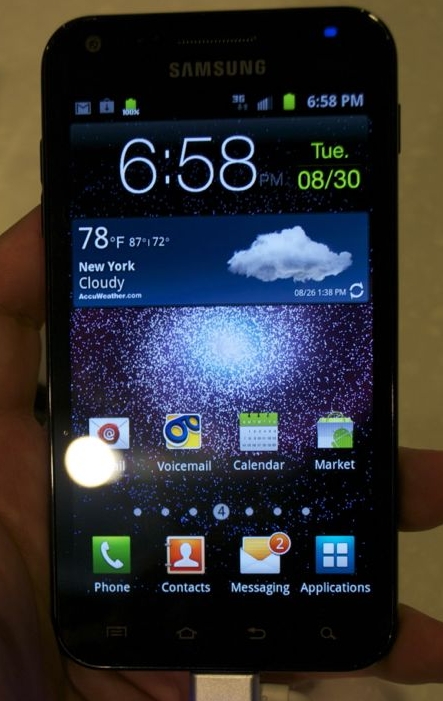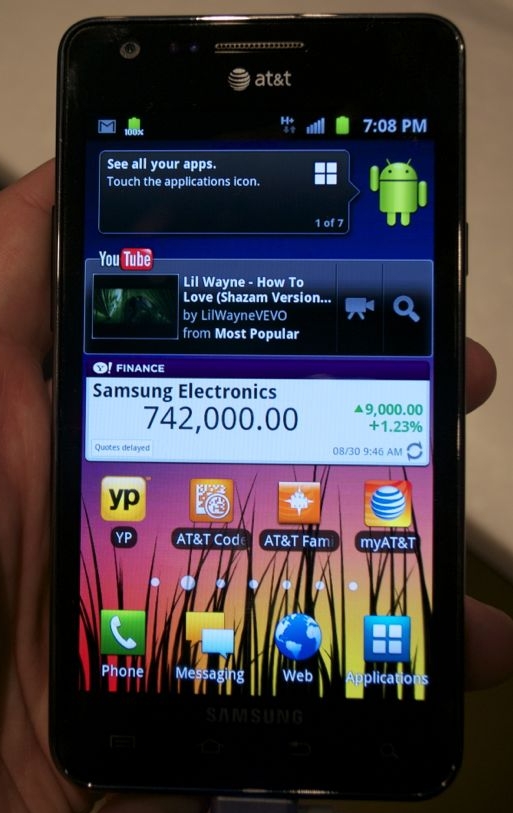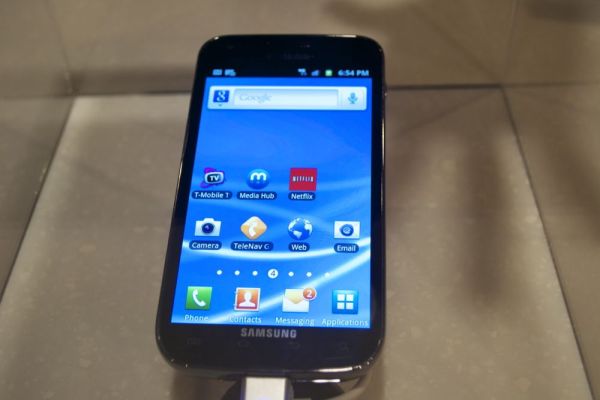Hands on with the US-bound Samsung Galaxy S IIs
by Jason Inofuentes on August 31, 2011 1:37 AM EST- Posted in
- Laptops
- Samsung
- Android 2.3
- Galaxy S II
- Mali 400
- TouchWiz
- Exnos
Samsung has already sold 5 million of them in 85 days in Korea and Europe, but until now the Galaxy S II has been just a dream in a US phone buyers eye. All that was rectified tonight when Samsung announced three Galaxy S II variants that will be entering the US market on Sprint, AT&T and T-Mobile. Brian already ran through the specifications but we thought we'd provide some hands-on impressions from our time with them and a little overview. TouchWiz 4.0 was also showed off, and the skin is comprehensive enough that we'll devote some time in the future to flesh it out. First, a gallery from the event. Apologies for some of the shots, but lining up the best shot in this evironment is impossible.
Sprint Epic 4G Touch

Sprint will be first out of the gates with the Epic 4G Touch, launching on September 16th for $199 on contract. The device is one of two 4.5" slates whose WVGA (800x480) Super AMOLED Plus display is bright and vivid, and surprisingly crisp given the relatively low resolution. There's no denying that pixel density enthusiasts would have been thrilled at 720p or even qHD, but in the hand the only real effect was to make the icons comically large. Horizontal size not withstanding these devices are light and thin, though Sprint's variant is not the thinnest clocking in nearly a millimeter thicker than AT&T's at 9.65 mm. On first grab the lightness gave the impression I was holding a mock-up and not the real thing, but this WiMAX equipped featherweight was smooth and fast in navigating the device's UI. Nenamark was loaded on the device so we ran it through its paces and though the benchmark is not one we regularly feature the device smoothly ran it at 46+FPS. For those thinking of joining The Now Network, this phone will be hard to pass up.
AT&T Samsung Galaxy S II

Ma Bell has foregone alternate naming for their variant, and as the pictures bear out, this is also the closest to the international version that has made the rounds through out Asia and Europe. The 4.3" device lends itself better to the WVGA resolution, and feels noticeably smaller in the hand. Absent in all of these devices is the physical home button so prominent in the international version, but each feels solid in the hand despite a glossy plastic exterior that doesn't feel as premium as the soft touch or metal frames found on recent HTC phones. AT&T's SGSII shares the Exynos SoC and Mali GPU of the Epic 4G Touch and international version so while it is smaller it is no less fast. An NFC radio is on hand, though it was not mentioned at the event it's confirmed by FCC documentation. Release and pricing have not been announced, but we imagine they won't stray far from Sprint's date and pricing. Though it wasn't listed in the specifications released tonight, the phone is rated for HSPA+ at 21.1 Mbps, matching the international version and most likely indicating that both are using the same X-Gold 626 baseband. So, with AT&T's model so closely aping the already shipping internation version, why not be the first out the door? Not sure, but we hope it means it's not long coming.
T-Mobile
T-Mobile is joining Sprint in the 4.5" form factor, though the demo models they had on hand presented rounder corners than Sprint's variant. And that's pretty much all we can say. Samsung and T-Mobile representatives committed to a dual-core processor but would go no further with launch date, pricing or specifications. Indeed, the demo models were kept under glass and not even the representatives were allowed to handle them, except to turn them on periodically so we could appreciate the display. As Brian pointed out in the earlier piece, this could end up being Qualcomm powered, in particular given that a dual core Snapdragon paired with Qualcomm's MDM8220 could make this T-Mo's first DC-HSPA+ 42 Mbps device.
Overview
Since its announcement back at Mobile World Congress in February, the Samsung Galaxy S II has generated a lot of excitement and that excitement has lead to impressive sales figures. This, of course, follows in the success of their first generation Galaxy S devices. But what is it about these phone's that is lighting the world on fire? In a big way, this has to do with Exynos, Samsung's succesor to Hummingbird. The two components of Exynos are a dual-core Cortex A9 clocked at 1.2 GHz and the Mali-400 GPU, both ARM designs. ARM states that clock-for-clock a single-core Cortex-A9 should outperform a Cortex-A8 by about 20%. Give that same A9 a 20% clock bump, and a 40% performance improvement is possible before the second core even comes into the picture. But that only tells us why the Galaxy S II is such a huge improvement over, say, the Nexus S.
What makes the Galaxy S II seem to drastically outpace newer devices like the Droid 3, whose 1 GHz OMAP 4 SoC also features an A9 processor? The special sauce, as Brian will delve into further in his upcoming review of the international Galaxy S II, is Samsung's ability to leverage the Mali-400 to accelerate UI elements and even elements of the browsing experience, as well.
September 16th is fast approaching, so we'll know soon just how well the US variants will perform relative to their international siblings. In the meanwhile, stay tuned for our review and some more Samsung news at the IFA Unpacked event on Thursday.

















36 Comments
View All Comments
Impulses - Wednesday, August 31, 2011 - link
She's gotta be having some sort of wake lock issue (app keeping the phone awake), either that or the Galaxy S2 has an issue with sleep state. If I don't use my EVO 3D at all it'll easily idle for 40+ hours, the thing sleeps like a champ even with FB and a couple of email accounts set to sync... The only other thing that could tap a phone dry withou any user input would be am excess of background sync services and/or a particularly bad signal. Nothing kills battery faster than sitting in a low signal area and allowing the phone to constantly and hopelessly struggle to find a stronger signal.InDenial - Wednesday, August 31, 2011 - link
It might be due to a known bug on that phone where the WiFi Sharing Manager starts up for no apparent reason and starts consuming the battery. The phone also gets very warm during this time. I use Watchdog Task Manager Lite to keep an eye on my CPU usage and if I notice it very high (constantly over 20%) it's usually becauase of that sharing manager. Go into Settings, Applications, Battery usage. Select wifi sharing if it's on the list and Force stop it. Samsung are supposedly working on a fix for their next firmware release. The sharing manager is normally only used while tethering.InDenial - Wednesday, August 31, 2011 - link
Also, with her usage and your settings, she should be able to get at least 2 days out of each charge. I usually get over 48 hours on that phone with a few texts and short calls and 1 or 2 hours of internet or games per day. If possible, use wifi at home rather than 3G as it's meant to be better for the battery. Otherwise, your settings are good. I've heard that using a dark/black background can save battery as it doesn't have to display strong bright colours.JasonInofuentes - Wednesday, August 31, 2011 - link
Remember that battery life isn't just what you actively do with it. If your girlfriend had a few 5 minute calls AND her phone was passively downloading e-mails, Twitter updates and Facebook data then it may have actually consumed a lot of its battery life in 3G data. Given that WiFi battery life is often better than 3G, you should consider seeing what her stand by time is if you turn WiFi on, set it to never disconnect, and see if it improves. If it does, then you should also consider changing your refresh intervals for whatever data hogs are consuming her battery life.Either way, I know Brian is working hard on putting together a great review of the international version. We don't typically do stand by time because it's too dependent on variables (how much e-mail we received that day, what our WiFi or 3G signal is like, etc) but hopefully our regular battery life tests will give you some idea whether you're phone is performing up to snuff. Thanks for the comments and keep them coming.
Jason
ssj4Gogeta - Wednesday, August 31, 2011 - link
It's probably the AOS bug, which is reportedly fixed in the leaked 2.3.4 update ROMs.Open battery use details, if you see "Android OS" using a high percentage of battery, then that is what you're experiencing. It affects all 2.3.3 ROMs including those for Galaxy S(1).
Mike1111 - Wednesday, August 31, 2011 - link
What about the just announced Galaxy S II LTE with a 1.5 GHz dual-core CPU? Seems unfortunate to finally release the Galaxy S II in the US right after announcing its successor (or more high-end SKU).s44 - Wednesday, August 31, 2011 - link
AT&T will probably release it late in the year when their LTE network goes online.JasonInofuentes - Wednesday, August 31, 2011 - link
Check in just after 5AM EST and we should have coverage of Sammy's IFA event.realmike15 - Wednesday, August 31, 2011 - link
I want to move away from the iPhone, but I haven't found a suitable replacement yet. I've had a chance to play with the Android OS and I was pleasantly surprised with it's performance and overall style. The handset makers on the other hand, just can't seem to get the design of their hardware right. Most of the phone styling out there pales in comparison to the iPhone. That's not a jab at the other manufacturers, there's plenty of problems with the iPhone... but from a hardware standpoint the design is just so sleek, minimalistic, and well done. The competitors phones just feel "cheap" in your hand, the mention of how "light" the galaxy feels does not instill confidence for me. I want a phone with some weight to it, it doesn't have to be heavy... but I want to know it's there. There's too much plastic in the mobile market, glass and metal are much better building materials. I'm not an Apple fan boy, I own both PC and Mac and probably always will. While I think Apple does great design work, it bothers me how slow they are to implement new technology like USB 3.0, or that the specifications of their computers usually don't match the price tag.Anyway, I'm not trying to turn this into a Mac vs. PC dead horse debate. I just don't understand why these other manufacturers can't design hardware that looks as good as Apples. I'd like to make the switch and try something new, but their hardware designs aren't even close.
Johnmcl7 - Wednesday, August 31, 2011 - link
The only aspect which is wrong with plastic for build quality is people's misperception of it. Plastics are easily at the stage that they can offer the necessary strength as well as lightness which metal cannot. The S2 and Sensation are a good example, people frequently favour the Sensation for its supposed better build quality but in truth it's just the feel. I'm using a newer Sensation at the moment which has a creaking rear cover already while the S2 is still flawless, no marks, no creaking it just feels solid.As for the IPhone build quality it perhaps proves that while its build quality may feel great the build quality is actually poor, the previous iterations suffered a variety of problems with the cases cracking and the screen breaking far too easily and based on Iphone4 friends have it's no better with its own share of problems. I'll take the superior plastic build quality of the S2 any day of the week